

|
| ČESKÁ REPUBLIKA | CZECH REPUBLIC |
| Pardubický kraj | Pardubice region |
| Okres: Pardubice |
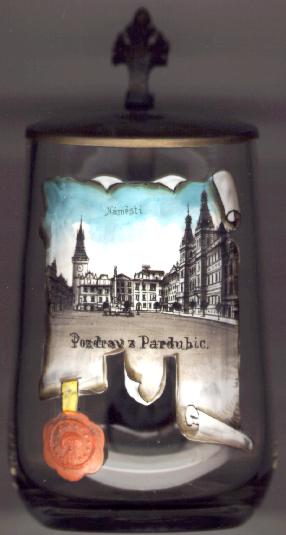
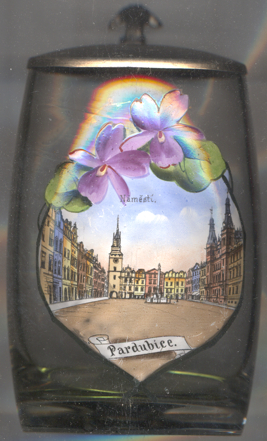 Pardubice is situated at an elevation of 221 m on the confluence of the rivers Labe (Elbe) and Chrudimka in East Bohemia. The earliest traces
of a historical settlement in this place have been dated to the end of the 12th century. The first written mention is found in a papal document of
1295 referring to a monastery of the Cyriac Knights near the church of St. Bartholomew in Parduby. The settlement began to develop near a
castle that protected the ford across the river where toll on floating timber was collected. Between 1332 and 1340, Pardubice obtained the status of a town.
Arnošt of Pardubice (ca. 1297–1364) was the first Archbishop of Prague and the fore advisor and diplomat to Emperor
Charles IV, King of Bohemia. Under Vilém of Pernštejn (1438–1521) and his family, Pardubice developed
from a little town into a residential town of the then richest and most influencial family in the country. By the year 1506 Pardubice had obtained the
status of a city and by the year 1512 it had a special constitution. After a large fire in 1538, Jan of Pernštejn (1487–1548) had the town
rebuilt in Renaissance style. The city became an estate of the Royal Chamber in 1560. During the Thirty Years' War (1618–1648), the fortifications of
the town were modernized, but although Pardubice could resist the attacks of the Swedish army, the town was largely destroyed by fire in 1645. During the
following centuries, the appearance of the town was shaped by the Baroque, Rococo, and Classicist styles. The modern development of the town was greatly
influenced by the opening of the railway lines from Olomouc (Olmütz) via Pardubice to Prague in 1845, from Pardubice to
Liberec (Reichenberg) in1859 and to Havlíčkùv Brod (Deutsch-Brod) in 1871. The
social life of the town during the last decades of the Austro-Hungarian Monarchy was greatly influenced by the Pardubice hunts. During that time also the
tradition of steeplechase came into being. The famous Velká pardubická (Grand Pardubice Steeplechase), which still takes place today, was
first held in 1874.
Pardubice is situated at an elevation of 221 m on the confluence of the rivers Labe (Elbe) and Chrudimka in East Bohemia. The earliest traces
of a historical settlement in this place have been dated to the end of the 12th century. The first written mention is found in a papal document of
1295 referring to a monastery of the Cyriac Knights near the church of St. Bartholomew in Parduby. The settlement began to develop near a
castle that protected the ford across the river where toll on floating timber was collected. Between 1332 and 1340, Pardubice obtained the status of a town.
Arnošt of Pardubice (ca. 1297–1364) was the first Archbishop of Prague and the fore advisor and diplomat to Emperor
Charles IV, King of Bohemia. Under Vilém of Pernštejn (1438–1521) and his family, Pardubice developed
from a little town into a residential town of the then richest and most influencial family in the country. By the year 1506 Pardubice had obtained the
status of a city and by the year 1512 it had a special constitution. After a large fire in 1538, Jan of Pernštejn (1487–1548) had the town
rebuilt in Renaissance style. The city became an estate of the Royal Chamber in 1560. During the Thirty Years' War (1618–1648), the fortifications of
the town were modernized, but although Pardubice could resist the attacks of the Swedish army, the town was largely destroyed by fire in 1645. During the
following centuries, the appearance of the town was shaped by the Baroque, Rococo, and Classicist styles. The modern development of the town was greatly
influenced by the opening of the railway lines from Olomouc (Olmütz) via Pardubice to Prague in 1845, from Pardubice to
Liberec (Reichenberg) in1859 and to Havlíčkùv Brod (Deutsch-Brod) in 1871. The
social life of the town during the last decades of the Austro-Hungarian Monarchy was greatly influenced by the Pardubice hunts. During that time also the
tradition of steeplechase came into being. The famous Velká pardubická (Grand Pardubice Steeplechase), which still takes place today, was
first held in 1874.
The  Plague Pillar [left, no. 419, and right, no. 3348: centre background, barely visible]
in the centre of the square was erected in 1698. The ballustrade around it was added in 1777.
Plague Pillar [left, no. 419, and right, no. 3348: centre background, barely visible]
in the centre of the square was erected in 1698. The ballustrade around it was added in 1777.
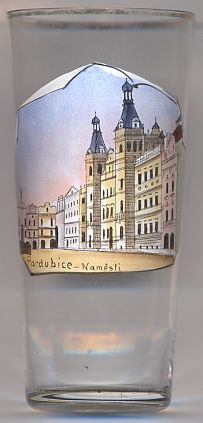
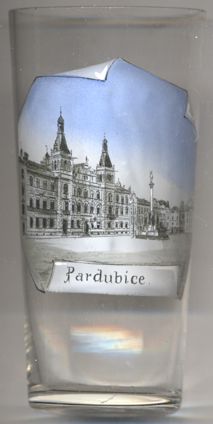
The Pardubice  town hall [near left, no.s 2169 and 4520] with its two characteristic towers was created by
rebuilding a number of older houses in 1892–1894.
town hall [near left, no.s 2169 and 4520] with its two characteristic towers was created by
rebuilding a number of older houses in 1892–1894.
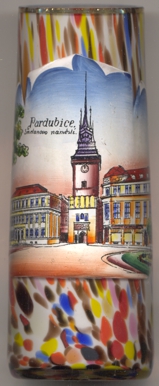
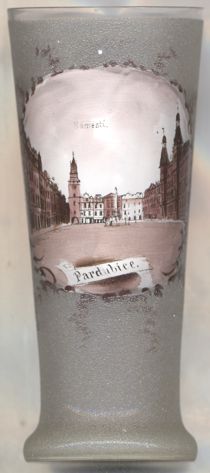
The so-called  Green Tower [near left, no. 4002: background] is the dominant historical monument in the old town centre.
In 1542, the old gate tower was heightened to its present height of 60 m and at the same time received its famous Early Renaissance copper roof,
which, after having oxidized, became the origin of the tower's name.
Green Tower [near left, no. 4002: background] is the dominant historical monument in the old town centre.
In 1542, the old gate tower was heightened to its present height of 60 m and at the same time received its famous Early Renaissance copper roof,
which, after having oxidized, became the origin of the tower's name.

... [Text in preparation]
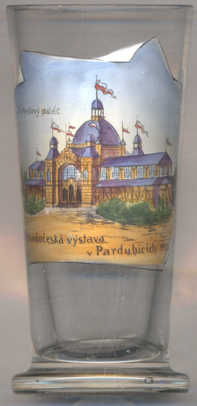
The East Bohemian Exhibition of 1903 took place in Pardubice from 27 July to 20 September.
It was conceived as an exhibiton of industry, agriculture, ethnography and art. At that time it was one of the largest
exhibitions in Bohemia outside Prague. Within two months the exhibition attracted more than
200,000 visitors.
Glass no. 3541 [left] shows a view of the
 Palace
Palace
[http://ipardubice2.sweb.cz/historie/vychodoceskavystava.html, http://www.parpedie.cz/cti-zaznam.php?id=Vystavy]
![[scale]](lineal.jpg)